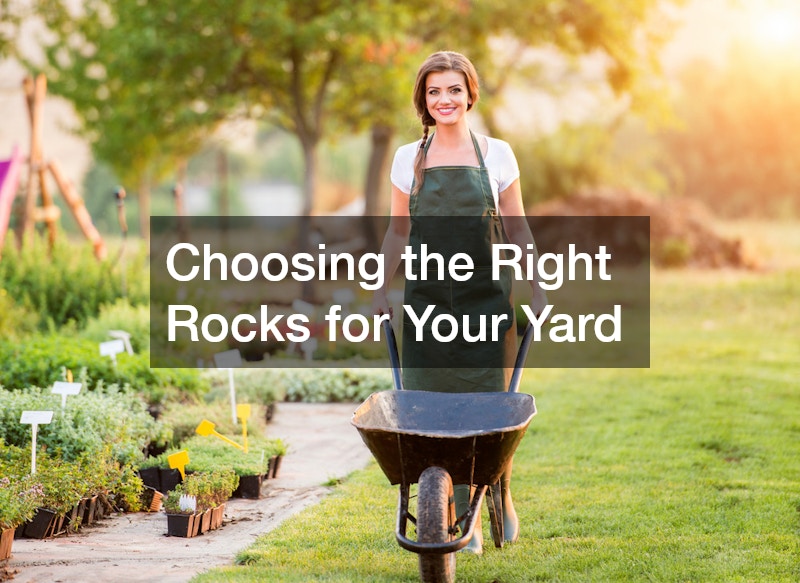Landscaping rocks bring texture, contrast, and long-lasting beauty to any outdoor space. Unlike plants that grow and change with the seasons, rocks add a permanent foundation that enhances design while remaining low-maintenance. Whether used for pathways, garden beds, or decorative accents, these stones can elevate a yard into a functional and visually appealing retreat. Below are 12 popular types of landscaping rocks and how they can be used effectively.
1. Pea Gravel
Pea gravel is small, smooth, and rounded, resembling tiny pebbles. It comes in a range of neutral tones such as tan, brown, and gray, making it a flexible choice for pathways, patios, and ground cover.
Its compacting nature helps reduce weed growth, while its soft texture makes it comfortable for walking.
2. River Rock
River rock features smooth, rounded surfaces created by natural water flow. These stones are larger than pea gravel and are commonly used in dry creek beds, garden borders, or around water features. Their variety of colors and sizes allows for both decorative and functional use.
3. Crushed Granite
Crushed granite consists of small, angular pieces of stone with a rougher texture. It is excellent for creating rustic pathways and patios. Its sharp edges lock together, making it a stable choice for high-traffic areas while providing a natural appearance.
4. Lava Rock
Lava rock, formed from volcanic activity, is lightweight and porous. Available in bold red and black tones, it adds a striking contrast to landscapes. Often used as mulch, lava rock helps retain soil moisture while resisting fading under the sun.
5. Flagstone
Flagstone slabs are flat and broad, ideal for creating patios, walkways, or stepping stones. Each piece has a unique shape and natural color variations, which adds character to any outdoor design. Flagstone’s durability and slip resistance make it a favorite for functional hardscapes.
6. Decomposed Granite
Decomposed granite is made of fine particles that create a soft, compact surface. It is often used for driveways, trails, or informal garden paths. Its earthy tones blend seamlessly into natural landscapes while providing a stable, permeable surface.
7. Marble Chips
Marble chips are bright white stones that reflect light beautifully, giving gardens a clean and elegant look. They are often used around flower beds, shrubs, or fountains to highlight greenery and create visual contrast. Marble chips also help deter pests due to their sharp edges.
8. Boulders
Large boulders serve as dramatic focal points in a landscape. They can be placed individually or grouped to form natural-looking arrangements. Beyond aesthetics, boulders can also provide structure by acting as retaining walls or anchoring sloped areas.
9. Slate Chips
Slate chips are flat, angular pieces of stone that typically appear in shades of gray, blue, or black. They are perfect for decorative ground cover, adding texture and depth to a space. Slate chips also absorb less heat, making them suitable for areas with direct sunlight.
10. Sandstone
Sandstone is known for its warm tones ranging from beige to red. It is often used for stepping stones, patios, or retaining walls. Its natural layering gives it a rustic charm, making it a versatile option for traditional or desert-themed landscapes.
11. Fieldstone
Fieldstone includes irregularly shaped rocks gathered from natural sources. It is commonly used for garden borders, fire pits, or rustic walls. Its organic appearance makes it an excellent choice for creating a natural, countryside look.
12. Cobblestone
Cobblestones are small, rounded stones traditionally used for paving streets. In landscaping, they add old-world charm to driveways, walkways, and edging. Their durability and timeless appeal make them a reliable choice for projects requiring both function and style.
Choosing the Right Rocks for Your Yard
When selecting rocks for landscaping, it is important to consider their function as well as their aesthetic qualities. For instance, crushed granite and pea gravel are ideal for walkways, while boulders and flagstone create strong visual impact. Marble chips and slate chips, on the other hand, work best for decorative accents and ground cover.
Additionally, pairing different rock types can enhance depth and interest. For example, a dry creek bed of river rock bordered by slate chips can balance rustic and modern elements. Incorporating these features with other landscaping materials such as wood, plants, and lighting can result in a well-rounded outdoor environment.
Landscaping rocks are more than just decorative elements—they add structure, character, and long-lasting appeal to outdoor spaces. From the subtle charm of pea gravel to the dramatic presence of boulders, each rock type offers unique benefits that can transform a yard. By thoughtfully choosing and combining these materials, homeowners can create inviting landscapes that reflect both functionality and personal style.

